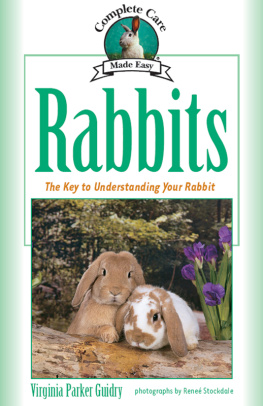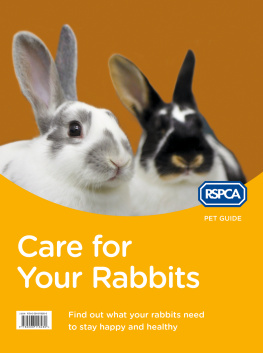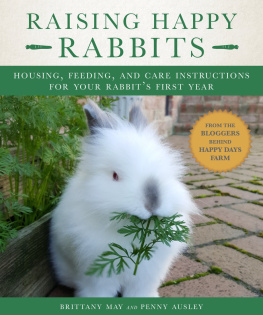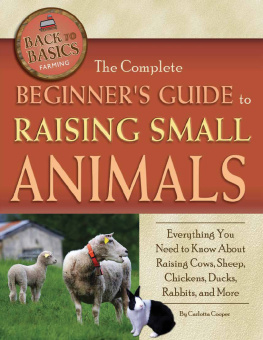Your R abbit
A Kids Guide to Raising and Showing
NANCY SEARLE

The mission of Storey Publishing is to serve our customers
by publishing practical information that encourages personal independence
in harmony with the environment.
Cover and text design by Carol J. Jessop
Cover photograph by Positive Images, Jerry Howard
Production by Carol J. Jessop
Edited by Gwen W. Steege and Lorin A. Driggs
Illustrations by Carol J. Jessop, with the exception of those on pages
Technical review by Terry E. Reed, D.V.M.
Indexed by Kathleen D. Bagioni
1992 by Storey Publishing, LLC
All rights reserved. No part of this book may be reproduced without written permission from the publisher, except by a reviewer who may quote brief passages or reproduce illustrations in a review with appropriate credits; nor may any part of this book be reproduced, stored in a retrieval system, or transmitted in any form or by any means electronic, mechanical, photocopying, recording, or other without written permission from the publisher.
The information in this book is true and complete to the best of our knowledge. All recommendations are made without guarantee on the part of the author or Storey Publishing. The author and publisher disclaim any liability in connection with the use of this information. For additional information, please contact Storey Publishing, 210 MASS MoCA Way, North Adams, MA 01247.
Storey books are available for special premium and promotional uses and for customized editions.
For further information, please call 12-7932.
Printed in the United States by Versa Press
30 29 28 27 26 25 24 23
Library of Congress Cataloging-in-Publication Data
Searle, Nancy, 1945
Your rabbit: a kids guide to raising and showing.
p. cm.
Includes bibliographical references and index.
Summary: A handbook for raising rabbits for pets, for profit, or to show.
ISBN-13: 9782-882662-6 (pbk.); ISBN-10: 02-767-X (pbk.)
1. RabbitsJuvenile literature. [1. Rabbits.] 1. Title.
SF453.2.S43 1992 | |
636.9322dc20 | CIP |
AC |
Contents
Choosing Your Breed of Rabbit
Choosing Your Rabbit
Handling Your Rabbit
Rabbit Housing
Feeding Your Rabbit
Taking Care of Your Rabbits Health
Breeding, Birth, and Care of Newborns
Showing Your Rabbit
Marketing Your Rabbit
Managing Your Rabbitry
Activities for Young Rabbit Owners
A Few words to Parents
As a parent, you want to direct your children toward positive experiences that will help prepare them for an active, productive, and independent future. Caring for a rabbit can be a very special learning opportunity for your child. The role of caregiver can help your child develop a sense of responsibility and a sense of compassion for others.
As a youth project, rabbits are gaining in popularity for many reasons:
 Rabbits can be raised almost anywherethey fit easily into most family settings.
Rabbits can be raised almost anywherethey fit easily into most family settings.
 Raising rabbits gives kids lots of options, from a beginners pet project to a breeding project and perhaps on to a small business venture.
Raising rabbits gives kids lots of options, from a beginners pet project to a breeding project and perhaps on to a small business venture.
 Rabbits are a good size animal for young children to work with. Young people are very capable of learning the skills necessary for a successful rabbit project.
Rabbits are a good size animal for young children to work with. Young people are very capable of learning the skills necessary for a successful rabbit project.
 It doesnt take a lot of money to get started with rabbitsthis project will fit into most family budgets.
It doesnt take a lot of money to get started with rabbitsthis project will fit into most family budgets.
Your personal interest and support will add greatly to your childs experience. Take time to work and learn together enjoy!
Introduction
Rabbits and kids have a lot in common. Both come in a variety of sizes, shapes, colors, and personalities. Both can live happily in country, suburban, or city settings. Because rabbits are small, you will be able to take responsibility for most, if not all, aspects of a rabbit-raising venture. When you are just starting out, you neednt spend a lot of money on expensive equipment, either. Although proper equipment contributes to the success of a rabbit project, it is more important for equipment to be functional than fancy. If you start with only one, or even up to three, rabbits, you can keep expenses fairly low. As you gain experience and knowledge, you can expand the number of animals under your care.
If you enjoy animals, you will discover that rabbits offer a wide variety of opportunities to learn new skills and participate in new activities.
Rabbits Are Mammals, Too
Like people, rabbits are classified by scientists as mammals. All mammals
 Are warm-blooded
Are warm-blooded
 Are nourished for a few weeks or months after birth on milk made by the mothers body
Are nourished for a few weeks or months after birth on milk made by the mothers body
 Have hair
Have hair
 Have more complex brains than other animals
Have more complex brains than other animals

Neither the jackrabbit nor the snowshoe rabbit is really a rabbit. Both of these animals are hares.
As scientists further break down the class of mammals, humans are grouped with other primates (including apes and monkeys), and rabbits are put into a special group called lagomorphs, which means hare-like. For a long time, rabbits were thought to belong to the rodent group, which includes other gnawing animals, such as rats, mice, and squirrels. Although rabbits are a lot like rodents, scientists saw enough differences to place rabbits in the group called lagomorphs. The biggest difference between rodents and lagomorphs is their teeth. Rabbits have six front teeth (four on the top, two on the bottom). Rodents have only four front teeth (two on the top and two on the bottom).
Lagomorphs are subdivided into two families: 1) pikas and 2) rabbits and hares. Pikas are small, short-eared animals that live in rocky, mountain areas. Many people use the word rabbit and the word hare to mean the same animal. Although the two are closely related, you can tell them apart in these ways:
 Hares are usually larger than rabbits. Their legs are longer, their ears are longer, and they run with long, high leaps.
Hares are usually larger than rabbits. Their legs are longer, their ears are longer, and they run with long, high leaps.
 Baby hares are born with fur, their eyes are open at birth, and they can move around shortly after they are born. Baby rabbits are born naked (without fur), their eyes are closed (they open at about 10 days), and they remain dependent on the mother for some time (5 to 8 weeks).
Baby hares are born with fur, their eyes are open at birth, and they can move around shortly after they are born. Baby rabbits are born naked (without fur), their eyes are closed (they open at about 10 days), and they remain dependent on the mother for some time (5 to 8 weeks).








 Rabbits can be raised almost anywherethey fit easily into most family settings.
Rabbits can be raised almost anywherethey fit easily into most family settings.